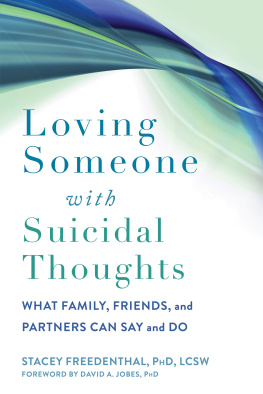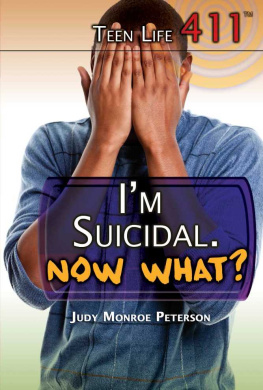I would like to extend my gratitude to Mary Mulcahy and Catherine Anne OConnell, two exceptional and passionate facilitators on the Adlerian Psychology Programme at LIT Tipperary. Thank you both for your encouragement and validation and sparking what has now become my passion.
I would also like to thank the teaching staff of PCI College for their support and feedback as I worked tirelessly to achieve my Counselling and Psychotherapy Degree. A special note of thanks to one of my core lecturers, Willie Egan; your sense of humour and compassion are admirable. Thank you for displaying such empathy, congruence and unconditional positive regard!
Dr Fergus Heffernan, you are a true inspiration and a very special person; thank you for sharing your life story and insights. I learned so much from you and will be eternally grateful that our paths crossed.
My practice supervisors, Marie OConnor and Frances Burke, thank you for listening, encouraging, validating and gently challenging me.
To my parents and siblings Sean, Mary and Steven, thank you for all that you taught me long before I learned the theory!
To Paul, my husband, thank you for believing in me, for all the cups of tea, and for feeding me as I endeavoured to complete this book. Thank you for making me realise that dreams can and do come true.
Sincere gratitude to Georgina of Hammersmith Books for realising the importance of the subject matter of this book.
During my training in Counselling and Psychotherapy I became very interested in self-harming and suicide due to its prevalence worldwide and as such conducted a great deal of research into the topic and engaged in further training in the area. Immediately after I qualified as a Counsellor and Psychotherapist I secured a position as a counsellor with a Self-Harm and Suicide Intervention Crisis Centre based in Ireland.
Through supporting stressed and distressed teenagers from 12 years upwards, I noticed common themes, presentations, thought processes and struggles which I have come to term self-defeatist syndrome. Many came to see me feeling anxious, scared, tired, overwhelmed, angry and isolated, with a very negative view of themselves and their abilities and a great sense of hopelessness and inadequacy. They could not see the beauty within them; it was clouded and forgotten, shadowed by thoughts of uselessness and feelings of inadequacy. There was no brightness or twinkle in their young eyes. Self-defeatist syndrome had taken hold and what I call the Gremlin had moved in and taken over their young minds and souls, causing havoc in their lives. These young teenagers did not know how to evict the Gremlin; many didnt even know it had moved in. You see, the Gremlin is stress that progresses to distress not a mental illness, but psychological distress that manifests in what I term self-defeatist syndrome.
This syndrome or collection of symptoms and features that tend to occur together causes our teenagers to become anxious, angry, hopeless, depressed, and to engage in self-harming; many consider and, unfortunately for some, complete suicide. In my experience, by employing an integrative approach which addresses the teenagers lifestyle, with a focus on nutrition, complementary therapies, talk therapy, exercise and community engagement, self-defeatist syndrome can be defeated and the Gremlin evicted!
I aim to guide readers through the steps and tasks of assisting a teenager in managing and overcoming the many challenges presented by this syndrome, with the ultimate goal of restoring mental wellbeing and family cohesion.
Sadly, self-defeatist syndrome has proven fatal and resulted in many young people worldwide completing suicide, with devastating consequences for their families and friends. In the final chapter of this book I address the impact of such a loss and guide readers through how to support those bereaved by the death of a loved one through suicide.
A person whose head is bowed and whose eyes are heavy cannot look at the light.
Christine de Pizan
What I will term self-defeatist syndrome throughout this book is the uninvited Gremlin that moves into young minds, metaphorically speaking. The Gremlin is STRESS that leads to DISTRESS, an unruly tenant that is powerful, deceitful and controlling. Its ultimate goal is to take control of a teenagers life in a destructive manner causing him/her to feel alone, depressed, angry, afraid, hopeless and anxious. The Gremlin is not a friend; the sooner it is evicted the better. The longer it stays the more powerful it becomes, taking the teenager hostage. The Gremlins goal is to isolate the teenager from family and friends, thus making itself even more powerful. It wants to make the teenager feel lonely and powerless, surrendering to the darkness, diminishing his/her light and self-esteem, distorting his/her belief system and sense of self.
The sense of self
The self relates to our uniqueness and individuality, our thoughts, feelings, perceptions and sense of worth, and how we view ourselves. The self also relates to our sense of identity, our belief system and values.
A teenager with a healthy sense of self will:
 feel confident and competent
feel confident and competent
 feel a sense of belonging and acceptance
feel a sense of belonging and acceptance
 feel secure, safe and valued
feel secure, safe and valued
 have self-discipline and self-control
have self-discipline and self-control
 learn from and move on from mistakes with new awareness
learn from and move on from mistakes with new awareness
 value his/her strengths and accept his/her weaknesses
value his/her strengths and accept his/her weaknesses














 feel confident and competent
feel confident and competent